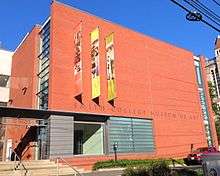Smith College Museum of Art
The Smith College Museum of Art (abbreviated SCMA), connected with the well-known Smith College, is a prominent art museum in Northampton, Massachusetts. It is considered to be one of the most impressive college museums in the country.[1] The museum is best known for its compilation of American and European art of the 19th and 20th centuries, including works by Edgar Degas, Jean-Baptiste-Camille Corot, Gustave Courbet, Paul Cézanne, Claude Monet, Georges Seurat, Albert Bierstadt, John Singer Sargent and others. First established in 1879,[2] the collection has expanded to include nearly 25,000 works of art, including a diverse collection of non-Western art. It is also a member of the Museums10 collective, a consortium of art, science, and history museums in Western Massachusetts. The SCMA serves as an important cultural and educational resource for the communities of Smith College, the Five College Consortium, and the town of Northampton.[3]
 Smith College Museum of Art | |

| |
| Established | 1870 |
|---|---|
| Location | 20 Elm Street, Northampton, Massachusetts |
| Type | Art museum |
| Accreditation | American Alliance of Museums |
| Director | Jessica Nicoll |
| Owner | Smith College |
| Website | www |
Building history
The Brown Fine Arts Center, which opened in 2003 after a two-year, $35 million building renovation,[4] now houses the art library, Art Department, and the Smith College Museum of Art. Designed by the New York City-based Polshek Partnership Architects (now known as Ennead Architects, the 164,000-gross-square-foot (15,236m²) building metaphorically and physically links the college with its neighboring community.[5]
Collections
The SCMA has an extensive collection including paintings, sculptures, works on paper (prints, drawings, photographs and books), antiquities, decorative arts, and Asian, African and Islamic art.[6] The museum contains four floors of galleries that house the permanent collection, the Cunningham Center for the Study of Prints, Drawings and Photographs, and rotating exhibitions.[7] The center houses more than 1,600 drawings, over 5,700 photographs spanning the history of the museum, and an extensive collection of more than 8,000 prints by artists from Albrecht Dürer to contemporary printmakers. In addition, the museum also features two bathrooms designed by artists Ellen Driscoll and Sandy Skoglund to represent functional art.[8]
Reflective of Smith's diverse student body and campaign to raise awareness of underrepresented groups of women, the museum has been actively procuring artworks by female artists and female artists of color. Notable figures represented in the collection include Betye Saar, Marja Vallila, Susan Rothenberg, Carmen Lomas Garza, and Nursa Latif Qureshi.[9]
The current director and chief curator is Jessica Nicoll.
Department of Art History
The History of Art degree at Smith College, initiated by President Seelye in the 1870s, has evolved to become one of the most respected programs in American undergraduate education today. Notable professors and art historical "greats" that have taught here include Henry-Russel Hitchcock, Adolph Katzenellenbogen,[10][11] Oliver Larkin, Rensselaer Wright Lee, Phyllis Williams Lehmann, Charles Rufus Morey, Edgar Wind and alumna Harriet Boyd Hawes. In the 10th International Congress of Art Historians, which took place in Rome in 1912, Smith was one of the only 68 American institutions of higher learning with a professorship in art history, out of a total of approximately 400 colleges and universities surveyed.[12] The museum is often utilized as a learning space for Smith students, especially for those who enroll in art and art history classes.
References
- "15 Most Impressive College Museums". onlinecollege.org. Retrieved 13 November 2014.
- "Collections history". Smith College Museum of Art. Retrieved 5 July 2013.
- "About". Smith College Museum of Art. Retrieved 13 November 2014.
- "Smith College Museum of Art". Museums10. Archived from the original on 24 November 2014. Retrieved 13 November 2014.
- Polshek, James S.; Rodriguez, Susan T. (2003). Brown Fine Arts Center: An Architecture of Transformation. Smith College.
- "Top College Art Museums". Departures. Retrieved 13 November 2014.
- "Overview". Smith College Museum of Art. Retrieved 13 November 2014.
- "Museum of Art: Restrooms As Functional Art". Brown Fine Arts Center. Retrieved 13 November 2014.
- "Nusra Latif Qureshi". Nusra Latif Qureshi. Retrieved 13 November 2014.
- "Adolf Katzenellenbogen". Dictionary of Art Historians. Retrieved 13 November 2014.
- "Rensselaer Wright Lee". Dictionary of Art Historians. Retrieved 13 November 2014.
- Davis, John (2003). True Proportion: Teaching the History of Art at Smith College. Smith College.